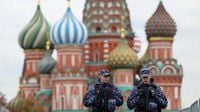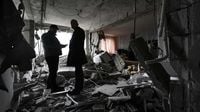In the early hours of October 27, 2025, the skies above western Russia lit up with the unmistakable flashes and booms of modern warfare. According to the Kyiv Independent, a massive overnight drone attack—one of the largest yet seen in the ongoing conflict—targeted multiple Russian regions, including the Moscow metropolitan area. Russian authorities scrambled to respond, with air defenses intercepting what they claimed were nearly 200 Ukrainian drones, some of which were reportedly heading straight for the Russian capital.
Residents in several districts of Moscow, including the Kommunarka area, awoke to the sounds of explosions and the sight of smoke rising above forested patches near local roads. Photos geolocated by Russian Telegram channels and cited by Astra captured the aftermath, showing emergency services converging on crash sites. Despite the chaos, Moscow Mayor Sergei Sobyanin reassured the public that, "emergency services were dispatched to all crash sites," and emphasized that no casualties had been reported in the capital itself.
But the night was far from uneventful elsewhere. In the Kursk region, just west of Moscow, a fire broke out near a power substation in the city of Rylsk. Governor Alexander Khinshtein explained, "As a result of the UAV attack, outbuildings caught fire near a house located close to the substation. Fire brigades extinguished the blaze." Meanwhile, a more tragic outcome unfolded in Bryansk, a region bordering Ukraine. There, a minibus was struck in the village of Pogar, killing the driver and injuring five passengers, as confirmed by Bryansk Governor Aleksandr Bogomaz on Telegram.
The scale of the assault was staggering. Russia’s Defense Ministry, as reported by multiple outlets including RBC-Ukraine and Moscow Times, stated that 193 Ukrainian drones were intercepted overnight, with 40 downed over Moscow Oblast alone and 34 of those specifically targeting the city. The ministry’s figures were echoed by Mayor Sobyanin, who said, "air defenses destroyed 36 drones approaching the capital between the evening of October 26 and early October 27." Emergency workers were deployed to the sites where debris landed, but again, officials maintained that no damage or injuries occurred within Moscow city limits.
The drone threat was significant enough to prompt the temporary closure of Domodedovo and Zhukovsky airports—two of Moscow’s four international hubs. The Russian aviation watchdog Rosaviatsiya cited air safety concerns for the closures, which led to five canceled and six delayed flights. Operations resumed about two hours later, but the disruptions underscored just how seriously authorities were taking the evolving threat. In fact, satellite imagery and open-source intelligence have revealed that Russia has expanded its air defense perimeter around Moscow over the past two months, constructing at least 21 new sites within a 50-kilometer radius, mostly to the south, and equipping them with S-300, S-400, and Pantsir missile-gun complexes.
On the ground in central Moscow, the response was equally visible—and, to some, a little surreal. As RBC-Ukraine reported, Russian security forces deployed mobile anti-drone units near the Kremlin. Photos showed troops mounted on Chinese-designed Sollers/JAC ST6 pickup trucks, armed with Pecheneg machine guns, patrolling the heart of the city. Yet these vehicles, observers noted, lacked night-vision or detection systems, making their effectiveness against low-flying drones in the dark questionable at best.
Fires broke out elsewhere, too. In Serpukhov, south of Moscow, an oil depot ignited on the evening of October 26, according to eyewitness footage cited by Astra. The local administration did not disclose the cause, but the blaze was quickly extinguished. Another fire was reported in a wooded area of Kommunarka, within the city limits, although officials did not specify what triggered it.
Ukraine’s government, for its part, remained silent on the specifics of the overnight operation. Kyiv has consistently declined to comment on individual strikes, but there’s little doubt about the broader strategy. Ukrainian forces have increasingly relied on long-range drones to strike deep into Russian territory, targeting military and industrial facilities—especially oil refineries, weapons factories, and ammunition depots. Just days before the latest wave of attacks, Ukrainian drones reportedly set the massive Ryazan refinery ablaze, following the announcement of new U.S. sanctions targeting Russia’s top oil producers, Rosneft and Lukoil. These measures, as U.S. Treasury Secretary Scott Bessent put it, are intended to choke off the Kremlin’s wartime funding: "As long as Putin refuses to end this senseless war, we are imposing sanctions on Russia's two largest oil companies that finance the Kremlin's war machine. We call on allies to join these sanctions."
Russia, meanwhile, continues its own campaign of missile and drone attacks against Ukrainian cities. Over the past two nights alone, strikes on Kyiv killed five people and injured dozens, according to Kyiv Independent and Daily Mail. On October 26, Kyiv’s mayor reported that two high-rise residential buildings were hit, with six children among the injured. President Volodymyr Zelensky stated that Russia had launched nearly 1,200 strike drones and 50 missiles—primarily ballistic—against Ukraine in just the past week.
Both sides publicly deny targeting civilians, but the toll of the war is clear. Thousands have died since Russia’s full-scale invasion began in February 2022, with the vast majority of casualties among Ukrainians. The conflict has evolved into a brutal contest of attrition, with each side seeking to cripple the other’s ability to wage war by targeting critical infrastructure—energy systems, refineries, and supply lines.
For Moscow’s residents, the new normal is one of heightened vigilance. Explosions in the night, airport closures, and the sight of armed patrols on city streets are now part of life in the Russian capital. Still, the authorities insist that the defenses are holding. Mayor Sobyanin’s repeated updates on social media, along with the rapid deployment of emergency services, are aimed at reassuring a population that’s never before faced such direct threats from the air.
Yet as the conflict grinds on, each new wave of drones and missiles only deepens the sense of uncertainty. With both sides demonstrating the ability—and the will—to strike far beyond the front lines, the war’s frontiers are increasingly blurred. The events of October 27, 2025, stand as a stark reminder that in modern conflict, no city is truly out of reach.


